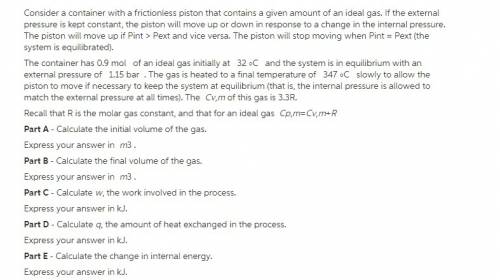
Consider a container with a frictionless piston that contains a given amount of an ideal gas. if the external pressure is kept constant, the piston will move up or down in response to a change in the internal pressure. the piston will move up if pint > pext and vice versa. the piston will stop moving when pint = pext (the system is equilibrated).

Answers: 1
Other questions on the subject: Physics

Physics, 22.06.2019 14:20, jeny89
4r-134a enters the condenser of a residential heat pump at 800 kpa and 50°c at a rate of 0.022 kg/s and leaves at 750 kpa subcooled by 3°c. the refrigerant enters the compressor at 200 kpa superheated by 4°c determine (a) the isentropic efficiency of the compressor, (b) the rate of heat supplied to the heated room, and (c) the cop of the heat pump. also, determine (d) the cop and rate of heat supplied to the heated room if this heat pump operated on the ideal vapor-compression cycle between the pressure limits of 200 and 800 kpa. (0.757, 4.37 kw, 5.12, 6.18, 3.91 kw)
Answers: 3

Physics, 22.06.2019 19:20, gokusupersaiyan12345
The dipole moment of the water molecule (h2o) is 6.17x10^-30 c. m. consider a water molecule located at the origin whose dipole moment p points in the +x-direction. a chlorine ion ( of charge-1.60x10^-19c , is located at x=3.00x10^-9m . assume that is much larger than the separation d between the charges in the dipole, so that the approximate expression for the electric field along the dipole axis can be used. a) find the magnitude of the electric force that the water molecule exerts on the chlorine ion. b) what is the direction of the electric force. -x-direction or +x-direction c) is this force attractive or repulsive?
Answers: 1

Physics, 22.06.2019 19:30, unknownday7
What characteristics of hv2112 make it the best candidate to be classified as a thorne-zytkow object?
Answers: 3

Physics, 22.06.2019 19:40, cordovatierra16
Two charged particles, q1 and q2, are located on the x-axis, with q1 at the origin and q2 initially at x1 = 12.2 mm. in this configuration, q1 exerts a repulsive force of 2.62 µn on q2. particle q2 is then moved to x2 = 18.0 mm. what is the force (magnitude and direction) that q2 exerts on q1 at this new location? (give the magnitude in µn.)
Answers: 1
Do you know the correct answer?
Consider a container with a frictionless piston that contains a given amount of an ideal gas. if the...
Questions in other subjects:

Mathematics, 08.09.2020 04:01

Mathematics, 08.09.2020 04:01

Mathematics, 08.09.2020 04:01


History, 08.09.2020 04:01

Mathematics, 08.09.2020 04:01

Mathematics, 08.09.2020 04:01

Mathematics, 08.09.2020 04:01









